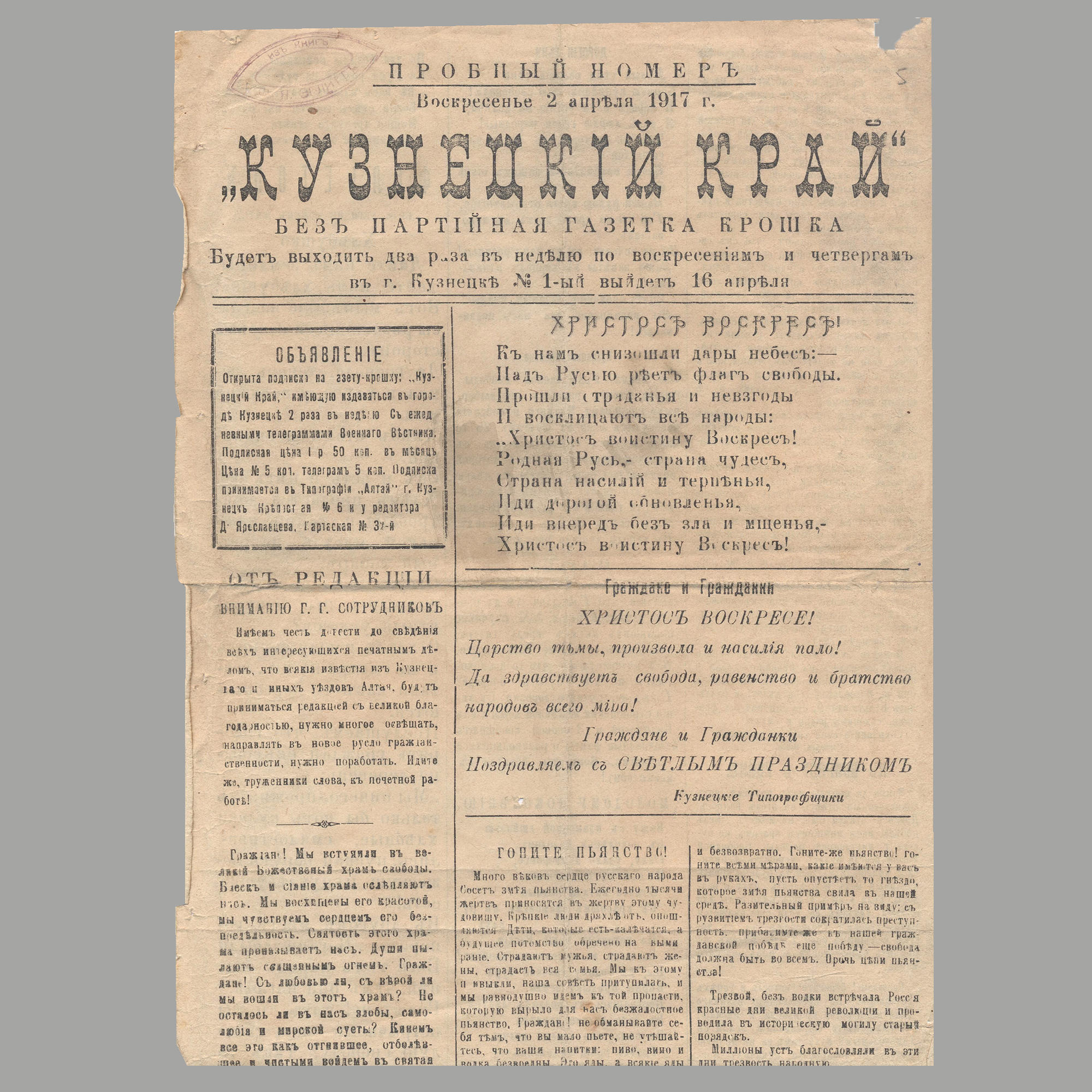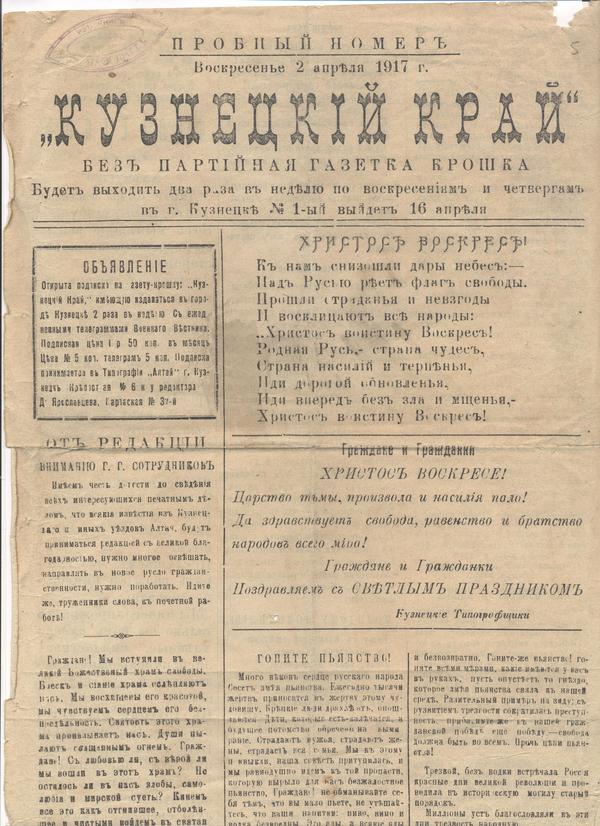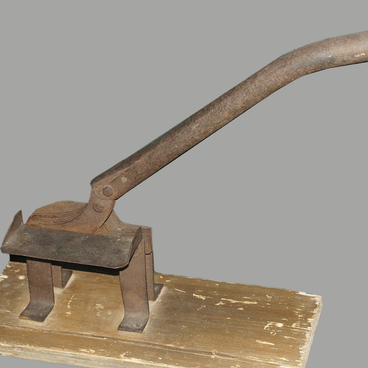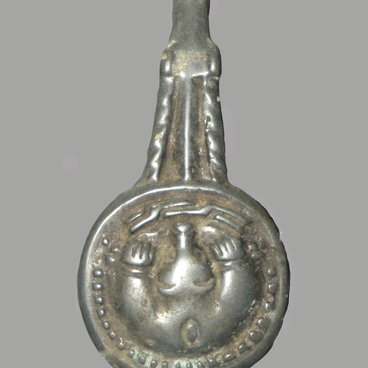The Kuznetskiy Krai (‘The Kuznetsk Region’) became the first local newspaper of the Kuznetsk Basin. The idea to issue a periodical occurred to Ivan Kokovin, a resident of Kuznetsk. In 1911, he moved to Kuznetsk from Irkutsk, and brought with him two typographic machines and a few sets of printing characters: small embossed lead bars to imprint letters on paper. That equipment was the base for the Altai printshop founded by Kokovin in 1913.
Initially, the printshop provided services mostly to government agencies: it printed various forms, questionnaires, account and office books. During the World War the printshop printed telegrams: narrow newspaper sheets with battlefield bulletins transmitted by the Petrograd Telegraph Agency.
For many years, Kokovin was dreaming of issuing a newspaper, but local authorities did not support that initiative. Percentage of the reading public in Kuznetsk was extremely low: the local library had only four registered readers while the population of the town was three thousand people. At last, after the February 1917 revolution, Kokovin received a permit to issue a tiny non-party newspaper.
With this purpose, he engaged two editors. The first one was a well-known local ethnographer Dmitry Yaroslavtsev. He travelled around Kuznetsk region, collected old household items, arms and objects of art, recorded local folklore, conducted geological expertise and practiced gold-digging. Yaroslavtsev’s systematic collection provided the basis for the first museum of regional ethnography in town.
The second editor of The Kuznetskiy Krai was Friedrich Eglitt, a native of the Governorate of Livonia (now the territory of Latvia). Eglitt graduated from the Law Department of the University of Dorpat. He was exiled to Siberia for his contacts with clandestine parties and soon became the first professional attorney in Kuznetsk.
Kokovin, Yaroslavtsev and Eglitt worked together on creating the first issues of the newspaper. They reported on various rallies, spotlighted on new public associations, called for battle against drunkenness. Also, The Kuznetskiy Krai published unelaborate commercial advertisements: For sale: a travelling carriage, little ridden or Newly fermented cabbage on offer, as well as movie listings of the Illusion private silent cinema.
The publishers intended to issue the newspaper twice a week, on Thursdays and Sundays. The equipment of the Altai Printshop allowed for 1,400 prints an hour, but the printshop employed only 12 people, therefore Kokovin, for whom his own periodical had been a true dream, often engaged himself in printing and binding operations.
However, The Kuznetskiy Krai was issued only twice: in April 1917 the trial and the first issues were published, after which the newspaper was shut down.
Initially, the printshop provided services mostly to government agencies: it printed various forms, questionnaires, account and office books. During the World War the printshop printed telegrams: narrow newspaper sheets with battlefield bulletins transmitted by the Petrograd Telegraph Agency.
For many years, Kokovin was dreaming of issuing a newspaper, but local authorities did not support that initiative. Percentage of the reading public in Kuznetsk was extremely low: the local library had only four registered readers while the population of the town was three thousand people. At last, after the February 1917 revolution, Kokovin received a permit to issue a tiny non-party newspaper.
With this purpose, he engaged two editors. The first one was a well-known local ethnographer Dmitry Yaroslavtsev. He travelled around Kuznetsk region, collected old household items, arms and objects of art, recorded local folklore, conducted geological expertise and practiced gold-digging. Yaroslavtsev’s systematic collection provided the basis for the first museum of regional ethnography in town.
The second editor of The Kuznetskiy Krai was Friedrich Eglitt, a native of the Governorate of Livonia (now the territory of Latvia). Eglitt graduated from the Law Department of the University of Dorpat. He was exiled to Siberia for his contacts with clandestine parties and soon became the first professional attorney in Kuznetsk.
Kokovin, Yaroslavtsev and Eglitt worked together on creating the first issues of the newspaper. They reported on various rallies, spotlighted on new public associations, called for battle against drunkenness. Also, The Kuznetskiy Krai published unelaborate commercial advertisements: For sale: a travelling carriage, little ridden or Newly fermented cabbage on offer, as well as movie listings of the Illusion private silent cinema.
The publishers intended to issue the newspaper twice a week, on Thursdays and Sundays. The equipment of the Altai Printshop allowed for 1,400 prints an hour, but the printshop employed only 12 people, therefore Kokovin, for whom his own periodical had been a true dream, often engaged himself in printing and binding operations.
However, The Kuznetskiy Krai was issued only twice: in April 1917 the trial and the first issues were published, after which the newspaper was shut down.



